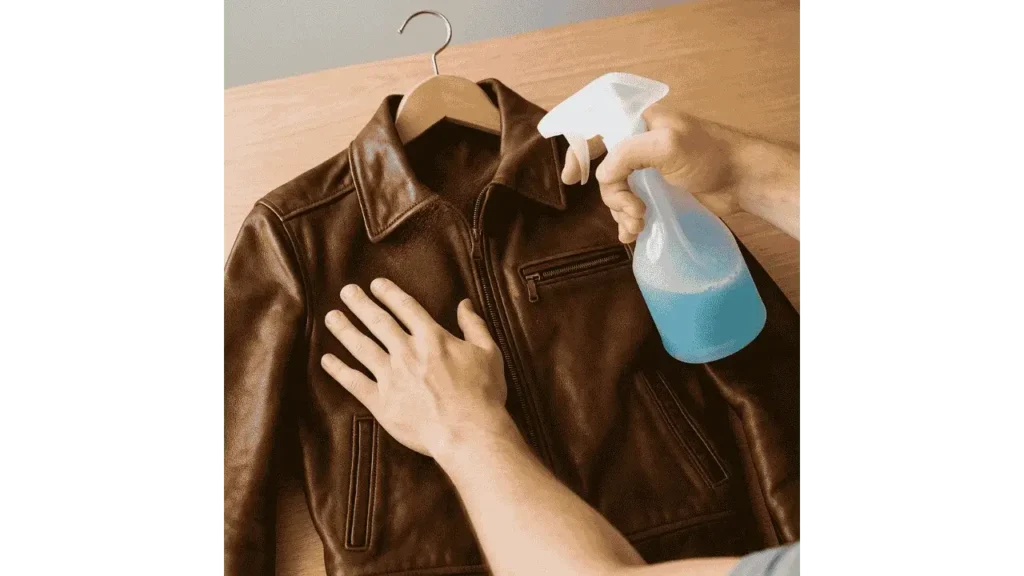A good leather jacket should hug the body, but when snug crosses the line into suffocating, a gentle stretch can save the day without sacrificing the hide’s longevity. Because leather is a natural, protein‑based material, it holds a small degree of elasticity that responds well to moisture, heat, and pressure, so long as each is applied in moderation. Misjudge the balance, though, and you risk cracks, hardened panels, or permanently warped seams. Below are safe, time‑tested ways to coax just a bit more room from a tight jacket while preserving its classic shape and sheen.

Spritzing with Water: Controlled Moisture for Subtle Give
Lightly misting the snug zones with lukewarm water relaxes the collagen fibers, making them pliable enough to expand but not so soaked that they lose structure. Slip the damp jacket onto your shoulders and wear it around the house as it dries, flexing your arms and rolling your shoulders. This movement persuades the leather to mold itself to your frame. Leather‑craft instructor Maria Delgado advises that
“short, repeated sessions of moisture and motion work far better than one heavy soaking, which can strip natural oils and speed up cracking.”
If the fit still feels constricted after the first round, repeat the process the next day rather than drowning the hide.
Using a Fabric‑Softener Mist: Relaxing Fibers Without Oversaturation
A few drops of fabric softener diluted in water act like a mild surfactant, penetrating the grain and encouraging flexibility. Mist the interior lining and underside of sleeves rather than the finished outer surface, then gently tug at tight spots with open palms, never pinch or pull sharply at seams. Follow up by wearing a sweatshirt underneath while the jacket air‑dries to cement the new fit. This method is ideal for jackets that feel rigid from storage but still retain natural oils.
Layer‑and‑Wear Method: Heat‑Free, Product‑Free Expansion
Sometimes patience is the safest tool. Put on a thick hoodie or fleece beneath the leather and go about daily chores. Body heat warms the fibers while the extra bulk exerts consistent outward pressure, gradually enlarging torso and sleeve circumference. The process may require several wears over a week, yet it carries zero risk of chemical or moisture damage and lets the leather stretch where your body naturally needs space.
Conditioning for Elasticity: Feeding the Fibers to Prevent Cracks
A quality leather conditioner replenishes lost oils, restoring suppleness and making the hide more receptive to stretch. Massage a thin layer into tight regions using circular motions, let it absorb for a few hours, then don the jacket over light layers to shape it. Master saddler Ethan Clarke notes,
“Condition first, stretch second. A pliable jacket yields smoothly; a dry one tears at the seam.”
Regular conditioning every few months not only eases adjustments but also preserves color and prevents surface crazing.
Final Takeaways
Safely stretching a leather jacket comes down to modest moisture, gradual pressure, and routine conditioning. Whether you spray a fine water mist, employ a fabric‑softener solution, layer up beneath the jacket, or nourish the hide with conditioner, always favor multiple light treatments over one aggressive session. Wear the jacket during each method so the leather conforms precisely to your silhouette, and monitor seams for stress. With care and patience, you’ll gain the comfort you need without compromising the jacket’s timeless appeal.
- How to Wear an Oversized Leather Jacket? Style Tips for a Casual Look - August 6, 2025
- How to Fold a Leather Jacket? - August 5, 2025
- How Should a Leather Jacket Fit a Woman? - August 1, 2025



